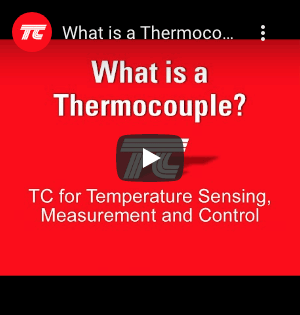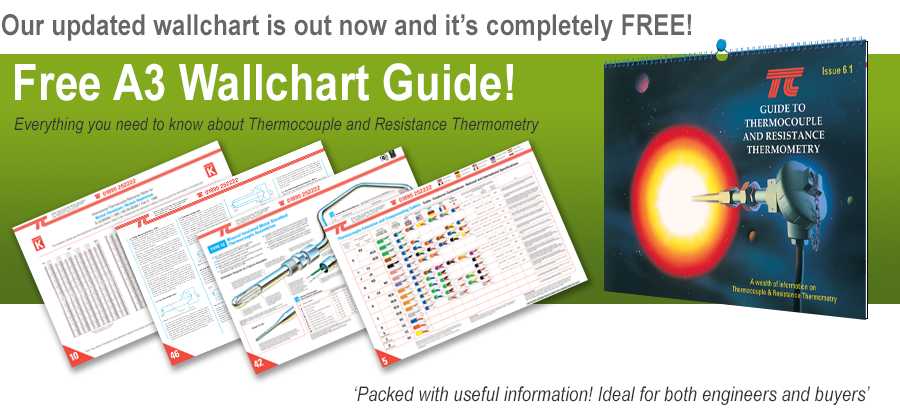Thermocouple Types
Thermocouple Types and Standards
Many combinations of materials have been used to produce acceptable thermocouples, each with its own particular application spectrum. However, the value of interchangeability and the economics of mass production have led to standardisation, with a few specific types now being easily available, covering by far the majority of the temperature and environmental applications.
These thermocouples are made to conform to an EMF/temperature relationship specified in the form of tabulated values of EMFs resolved normally to 1µV against temperature in 1°C intervals and vice versa. Internationally, these voltage reference tables are published as IEC 60584-1 (BS EN 60584-1). It is worth noting here, that the standards do not address the construction or insulation of the cables themselves or other performance criteria. With the diversity to be found, manufacturers’ own standards must be relied upon in this respect.
The standards cover the eight specified and most commonly used thermocouples, referring to their internationally recognised alpha character type designations and providing the full reference tables for each. See the reference tables published in this guide. At this point, it’s worth looking at each in turn, assessing its value, its properties and its applicational spread. Note that the positive element is always referred to first. Note also that, especially for base metal thermocouples, the maximum operating temperature specified is not the be all and end all. It has to be related to the wire diameter - as well as the environment and the thermocouple life requirements.
Thermocouple Types according to IEC 60584-1
Type K - Nickel-Chromium vs Nickel-Aluminium
 Thermocouple Type K, also referred to as Chromel-Alumel, is the most common thermocouple in use today mainly because it is reliable, inexpensive, has a wide temperature range and is reasonably accurate. K type thermocouples are designed primarily for general temperature measurements in normal atmospheres. Maximum continuous temperature is about 1,100°C, although above 800°C oxidation increasingly causes drift and decalibration. For short term exposure, however, there is a small extension to 1,200°C. For more information, please see our dedicated Type K thermocouple page.
Thermocouple Type K, also referred to as Chromel-Alumel, is the most common thermocouple in use today mainly because it is reliable, inexpensive, has a wide temperature range and is reasonably accurate. K type thermocouples are designed primarily for general temperature measurements in normal atmospheres. Maximum continuous temperature is about 1,100°C, although above 800°C oxidation increasingly causes drift and decalibration. For short term exposure, however, there is a small extension to 1,200°C. For more information, please see our dedicated Type K thermocouple page.
Type J - Iron vs Copper-Nickel
 Thermocouple Type J, commonly referred to as Iron/Constantan, this is one of the few thermocouples that can be used safely in reducing atmospheres. However, in oxidising atmospheres above 550°C, degradation is rapid. Maximum continuous operating temperature is around 800°C, although for short term use, temperatures up to 1,000°C can be handled. Minimum temperature is -210°C, but beware of condensation at temperatures below ambient - rusting of the iron arm can result, as well as low temperature embrittlement. For more information, please see our dedicated Type J thermocouple page.
Thermocouple Type J, commonly referred to as Iron/Constantan, this is one of the few thermocouples that can be used safely in reducing atmospheres. However, in oxidising atmospheres above 550°C, degradation is rapid. Maximum continuous operating temperature is around 800°C, although for short term use, temperatures up to 1,000°C can be handled. Minimum temperature is -210°C, but beware of condensation at temperatures below ambient - rusting of the iron arm can result, as well as low temperature embrittlement. For more information, please see our dedicated Type J thermocouple page.
Type T - Copper vs Copper-Nickel
 Thermocouple Type T, whose original name was Copper-Constantan, has found quite a niche for itself in laboratory temperature measurement over the range -250°C to 400°C - although above this the copper arm rapidly oxidises. Repeatability is excellent in the range -200°C to 200°C (±0.1°C). Points to watch out for include the high thermal conductivity of the copper arm, and the fact that the copper/nickel alloy used in the negative arm is not the same as that in Type J - so they’re not interchangeable. For more information, please see our dedicated Type T thermocouple page.
Thermocouple Type T, whose original name was Copper-Constantan, has found quite a niche for itself in laboratory temperature measurement over the range -250°C to 400°C - although above this the copper arm rapidly oxidises. Repeatability is excellent in the range -200°C to 200°C (±0.1°C). Points to watch out for include the high thermal conductivity of the copper arm, and the fact that the copper/nickel alloy used in the negative arm is not the same as that in Type J - so they’re not interchangeable. For more information, please see our dedicated Type T thermocouple page.
Type N - Nickel-Chromium-Silicon vs Nickel-Silicon
 Thermocouple Type N, was billed as the revolutionary replacement for the Type K thermocouple (the most common in industrial use), but without its drawbacks - Type N (Nicrosil-Nisil) exhibits a much greater resistance to oxidation-related drift at high temperatures than its rival, and to the other common instabilities of Type K in particular, but also the other base metal thermocouples to a degree. It can thus handle higher temperatures than Type K (1,280°C, and higher for short periods). For more information, please see our dedicated Type N thermocouple page.
Thermocouple Type N, was billed as the revolutionary replacement for the Type K thermocouple (the most common in industrial use), but without its drawbacks - Type N (Nicrosil-Nisil) exhibits a much greater resistance to oxidation-related drift at high temperatures than its rival, and to the other common instabilities of Type K in particular, but also the other base metal thermocouples to a degree. It can thus handle higher temperatures than Type K (1,280°C, and higher for short periods). For more information, please see our dedicated Type N thermocouple page.
Type E Nickel-Chromium vs Copper-Nickel
Thermocouple Type E, also known as Chromel-Constantan, is known for its high output - the highest of the commonly used devices, although this is less significant in these days of ultra stable solid state amplifiers. The usable temperature range extends from about -250°C (cryogenic) to 900°C in oxidising or inert atmospheres. Recognised as more stable than Type K, it is therefore more suitable for accurate measurement. However, Type N still ranks higher because of its stability and range. For more information, please see our dedicated Type E thermocouple page.
Type S - Platinum-10% Rhodium vs Platinum
Thermocouple Type S can be used in oxidising or inert atmospheres continuously at temperatures up to 1600°C and for brief periods up to 1700°C. For high temperature work, insulators and sheaths made from high purity recrystallised alumina are used. In fact, in all but the cleanest of applications, the device needs protection in the form of an impervious sheath since small quantities of metallic vapour can cause deterioration and a reduction in the EMF generated. Continuous use at high temperatures also causes degradation, and there is the possibility of diffusion of rhodium into the pure platinum conductor - leading to a reduction in output. For more information, please see our dedicated Type S thermocouple page.
Type R - Platinum-13% Rhodium vs Platinum
Thermocouple Type R is similar to the Type S combination, this thermocouple has the advantage of slightly higher output and improved stability. In general Type R thermocouples are preferred over Type S, and applications covered are broadly identical. For more information, please see our dedicated Type R thermocouple page.
Type B Platinum-30% Rhodium vs Platinum-6% Rhodium
Thermocouple Type B was developed in the 1950’s, and can be used continuously up to 1,600°C and intermittently up to around 1,800°C. In other respects the device resembles the other rare metal based thermocouples, Types S and R, although the output is lower, and therefore it is not normally used below 600°C. An interesting practical advantage is that since the output is negligible over the range 0°C to 50°C, cold junction compensation is not normally required.
The above list shows the more popular types of thermocouple used in the UK, other thermocouple types that you might come across, such as Type B and Type C thermocouples, are generally for use in more specialised applications, usually at higher temperatures, and a brief description of these can be found below:
Other Thermocouple Types
Type C Tungsten-5% Rhenium vs Tungsten-26% Rhenium (IEC 60584-1)
Formerly known as W5, Type C thermocouples (and all Tungesten/Rhenium alloy combinations in general) offer reasonably high and relatively linear EMF outputs for high temperature measurement. These types of thermocouples should be used in vacuum, inert atmospheres or dry hydrogen applications. Above 1200°C tungsten can become brittle due to recrystallisation.
Type A Tungsten-5% Rhenium vs Tungsten-20% Rhenium (IEC 60584-1)
Similar to Type C above, Type A thermocouple have a slightly extended temperature ranges, up to 2500°C.
Non Standard Thermocouples
Although there have been many, many thermocouple combinations developed over the years, almost all are no longer available or in use (except for very specialised applications, or for historical reasons). There are, however, four main non-standard types which continue to have their place in thermocouple thermometry.
Other Tungsten – Rhenium Thermocouple
There are two other primary combinations of this thermocouple: Type G (Tungsten vs Tungsten-26% Rhenium) and and D (Tungsten-3% Rhenium vs Tungsten-25% Rhenium). Both can be used up to 2,300°C and for short periods up to 2,750°C in vacuum, pure hydrogen, or pure inert gases. Above 1,800°C, however, there can be problems with rhenium vaporisation. As for insulators, beryllia and thoria are generally recommended, although again problems can occur at elevated temperatures, with wires and insulators potentially reacting.
Iridium-40% Rhodium vs IridiumBeing the only rare metal thermocouple that can be used in air without protection up to 2,000°C (short term only), these devices can also be used in vacuum and inert atmospheres. However, there are no standard reference tables, and users must depend upon the manufacturer for batch calibrations. Also, embrittlement after use at high temperatures is possible.
3.12 Platinum-40% Rhodium vs Platinum-20% RhodiumRecommended for use instead of Type B where slightly higher temperature coverage is required, this sensor can be used continuously at up to 1,700°C, and for short term exposure up to 1,850°C. Beyond this, the application rules as described for Type S apply. There are no standard reference tables, but normally batch calibrations are available from the manufacturer.
3.13 Nickel-Chromium vs Gold-0.07% IronThis is probably the ultimate thermocouple specifically for cryogenics, being designed to measure below 1K, although it fares better at 4K and above. Reference tables have been published by the National Bureau of Standards, but in Europe the negative leg alloy is more commonly gold-0.03% iron.

 France
France Germany
Germany Spain
Spain Netherlands
Netherlands Italy
Italy Hungary
Hungary United States
United States Australia
Australia

